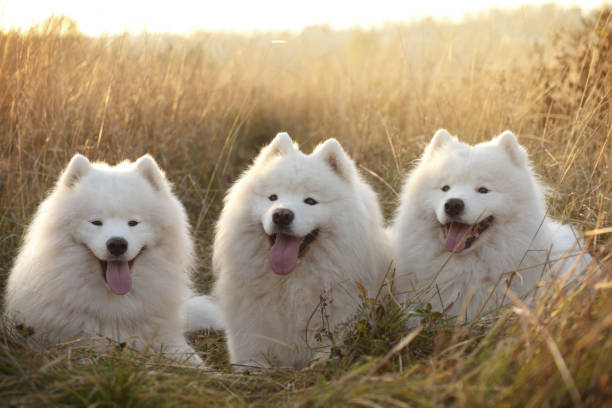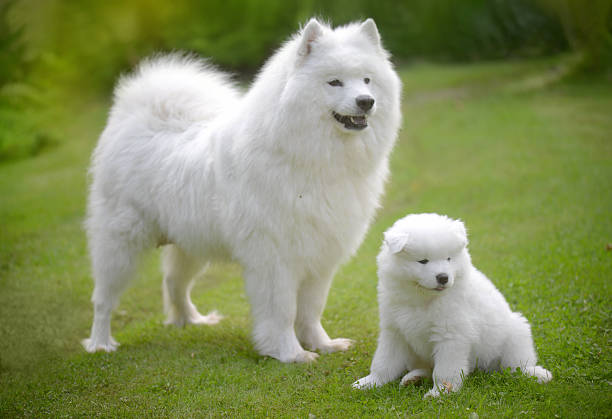The Samoyed people have lived with small white-tipped people for centuries, also called Samoyed because of their close connection to the Norse culture in Siberia. The versatile working dogs are now bred all over the world and also adapt to the hot climates of Australia and Zimbabwe. You can find out in our overview how you can organize everyday life with a Samoyed by your side.
How is the Samoyed Recognizable?
The Samoyeds, who live far to the north, are significantly larger than German Spitz breeds, with an ideal height at the withers of 57 cm for males and 53 cm for females. They weigh up to 30 kilograms (bitches at least 17 kilograms) and are similar in stature to the Wolfspitz. The distinctive feature of the Samoyed is its snow-white fur, which grows long and slightly sticks out all over the body (apart from the face) so that it looks very fluffy and gives the dog’s appearance some volume. Cream-colored Samoyeds and dogs with white fur and a light bisque coloring as a coat on the back and neck are also permitted. Light brown Samoyed puppies with white markings are also rarely born, but this is considered a breeding error.
An overview of other characteristics of the Samoyed: What’s under the white fur?

- The muzzle and head are about the same length and taper towards the snout in a wedge shape. The nose is black in all dogs, in winter the so-called winter nose visibly brightens in the middle. The stop at the bridge of the nose is clearly visible, the forehead furrow is hardly pronounced.
- The lips are relatively thick and pigmented black. They pull themselves up toward the outer corners of their eyes in a relaxed posture, creating the smiling expression that dogs are known for.
- The eyes also appear friendly and smiling. They are far apart and slightly slanted, the outer corners of the eyes are well defined by the black pigmentation of the skin. Yellow or light blue eyes are rare, but these dogs must not be used for breeding.
- The dog can adjust its relatively small and thick erect ears freely. At rest, they are tilted forward, and the tips are slightly rounded. They start high up on the skull.
- The body is slightly longer than it is high, with pronounced withers and a slightly sloping croup. The loins are short and strong, the chest is deep and ample. A characteristic mane forms on the back of the head and on the neck, which frames the head and is very pronounced in male dogs.
- The shoulders and upper arms are sloping and lie close to the body. The toes are relatively long, the front paws appear oval. The dogs are well-muscled on the hind legs. The knees are slightly bent, the rear metatarsus is vertical.
- The tail is very flexible and clearly shows the mood of the dog. When at rest it sometimes hangs down to the hocks, when excited and happy it is carried rolled up over the back. She is very well feathered.
Confusingly similar: Samoyeds and their close relatives
- Among the German Spitz, the Großspitz comes closest. However, the Samoyed is significantly larger and has a stronger physique.
- The American Eskimo Dog is an American variation of the Großspitz and again somewhat smaller than the Großspitz, so it is easy for those who know the breed to distinguish it from the Samoyed.
- In Wolfspitz, the color gray dominates the coat pattern. In addition, the mane around the head is not as voluminous and fine as with the Samoyed.
- The Eurasier originated from crosses between Wolfspitz, Chow-Chows, and Samoyeds. It rarely comes in white, and the backs of the legs, mane, and tail are not quite as heavily feathered as in the Samoyed.
- In contrast to other European Spitz, the Samoyed has a rather calm nature, it rarely becomes aggressive towards strangers and does not show any hunting instincts.
The Sled Dog of Explorers and Explorers: The Story of the Samoyed
In the second half of the 19th century, British and German explorers began embarking on the first expeditions to the North Pole and exploring the frigid north of Russia. The hardy dogs of the Samoyed peoples in Siberia proved useful on expeditions: researchers used the animals as sled dogs, and with the advent of systematic pure breeding of breeds around the turn of the century, the first specimens came to England.
The Samoyed in Europe

In 1889, British zoologist Ernest Kilbourne Scott imported the first white and cream dogs from Siberia. In their Russian homeland, the Samoyed dogs still come in various colors, from white and cream to brown and black to two-tone colors and sable colors. However, these colors are not recognized as purebred by the FCI. Because the original breeding stock was very small, but the dogs very quickly enjoyed worldwide popularity, numerous hereditary diseases occur in the breed today.
The Samoyed in its Russian homeland
The Samoyed peoples have lived with their peaks probably since their settlement in Siberia. The Samoyed shares its roots with many other Nordic Spitz breeds as well as the Japanese Spitz. Some cynologists are of the opinion that the ancestors of today’s Spitz breeds could have developed in part independently of one another – externally, however, the Spitz breeds that are settled on the intercontinental are similar in a striking number of details.